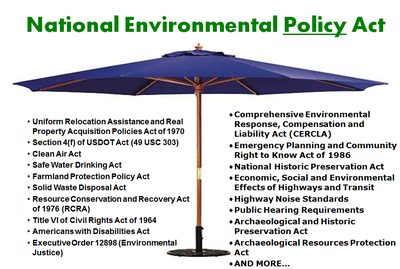NEPA
Program Overview
The mission of the CDOT NEPA Program is to support the five CDOT Regions with the preparation of high quality National Environmental Policy Act (NEPA) documents. The staff reviews statewide transportation projects to ensure compliance with applicable laws, regulations, and policies. They also develop guidance and provide training with regard to the requirements of NEPA.
NEPA Overview
NEPA, or the National Environmental Policy Act of 1969 (42 USC 4321-4335), was enacted to promote a national policy for protection of the environment and to raise awareness of the importance of natural resources to the nation. NEPA requires federal agencies, in cooperation with state and local governments, to address the environmental impacts of a proposed federal action or an action that receives federal funds. NEPA also established the Council on Environmental Quality (CEQ), which developed regulations (40 CFR 1500-1508) for implementing the procedural provisions of NEPA. NEPA requires preparation of an environmental document addressing the impacts associated with a project and to avoid, minimize, or mitigate those impacts. See below for the three types of NEPA documentation.
Why do transportation projects require environmental evaluation?
NEPA applies to project decisions or funding made by all federal agencies, including the Federal Highway Administration (FHWA) and Federal Transit Administration (FTA). Any federal project, or a state or locally funded project requiring a federal action, must meet NEPA requirements. CDOT must comply with NEPA and the environmental procedures established by FHWA.
What are the types of NEPA documents?
Class I - Environmental Impact Statements
Draft and Final Environmental Impact Statements (DEIS and FEIS) are prepared when a proposed project is likely to cause significant impacts on the environment. After completion and publication of the FEIS, a Record of Decision (ROD) is prepared that presents the basis for the decision made on the project.
Class II - Categorical Exclusions
A Categorical Exclusion is prepared for actions that do not individually or cumulatively have a significant impact. See 23 CFR 771 for more detailed information.
Class III - Environmental Assessments
An Environmental Assessment (EA) is prepared when it is not immediately clear what the impacts of a proposed project will be. If no significant impacts are identified in the EA, a Finding of No Significant Impact (FONSI) is prepared. Conversely, if it is determined that the project is likely to have a significant impact on the environment, then preparation of a DEIS is required.
